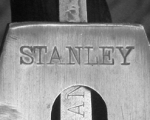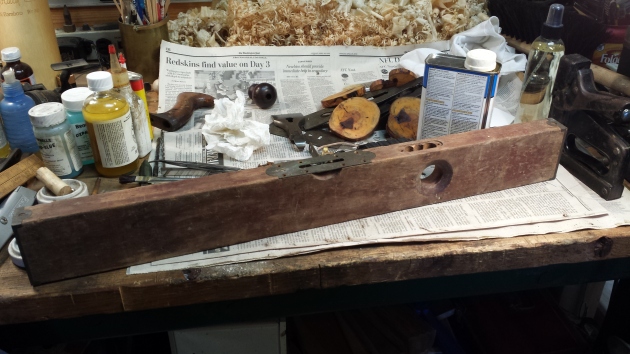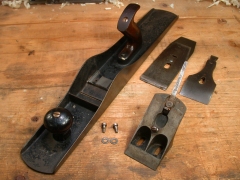 I spent this past week on vacation at the beautiful Outer Banks of North Carolina. The OBX is one of my favorite places on earth, and I’ve been visiting just about every year for the past 30 years. Despite its growth and development, especially over the last 20 years, there is still something raw about the Outer Banks. Mother Nature may have yielded some of her land, but the spirit of the place is still very much wild, a precarious thin line of sand at the mercy of the Atlantic Ocean. It was here, on the sandy dunes of Kitty Hawk and Kill Devil Hills back in December of 1903, that Orville and Wilbur Wright first flew a heavier-than-air craft under its own power.
I spent this past week on vacation at the beautiful Outer Banks of North Carolina. The OBX is one of my favorite places on earth, and I’ve been visiting just about every year for the past 30 years. Despite its growth and development, especially over the last 20 years, there is still something raw about the Outer Banks. Mother Nature may have yielded some of her land, but the spirit of the place is still very much wild, a precarious thin line of sand at the mercy of the Atlantic Ocean. It was here, on the sandy dunes of Kitty Hawk and Kill Devil Hills back in December of 1903, that Orville and Wilbur Wright first flew a heavier-than-air craft under its own power.
 Sitting on a dune deck overlooking the Atlantic just a few miles from Kitty Hawk this week, I got to thinking about just what kind of tools the Wright brothers might have used when building the Wright Flyer. The plane’s wings were constructed of spruce and ash covered with muslin. The rest of the frame was metal, not at all surprising considering the Wrights were machinists, not woodworkers. After all, they designed and developed the Flyer in their Ohio bicycle shop. They favored coastal North Carolina for its windy dunes and because it was remote – competition for flight was intense and they didn’t want a lot of press at that point.
Sitting on a dune deck overlooking the Atlantic just a few miles from Kitty Hawk this week, I got to thinking about just what kind of tools the Wright brothers might have used when building the Wright Flyer. The plane’s wings were constructed of spruce and ash covered with muslin. The rest of the frame was metal, not at all surprising considering the Wrights were machinists, not woodworkers. After all, they designed and developed the Flyer in their Ohio bicycle shop. They favored coastal North Carolina for its windy dunes and because it was remote – competition for flight was intense and they didn’t want a lot of press at that point.
Fortunately, the construction of the plane has been exhaustively researched and documented, not a task as simple as one might assume since the Wrights were very secretive, didn’t keep detailed plans of the design, and constantly made changes on the fly (no pun intended). [1] The plane’s framework “floated” within fabric pockets sewn inside, making the muslin covering an integral part of the structure. This ingenious feature made the aircraft light, strong, and flexible. The 1903 Flyer was powered by a simple four-cylinder engine of the Wrights’ own design. To fly the airplane, the pilot lay prone with his head forward, his left hand operating the elevator control. Lateral control was achieved by warping the wing tips in opposite directions via wires attached to a hip cradle mounted on the lower wing. The pilot shifted his hips from side to side to operate the mechanism, which also moved the rudder. [2]
| Wingspan: |
12.3 m (40 ft 4 in) |
| Length: |
6.4 m (21 ft) |
| Height: |
2.8 m (9 ft 3 in) |
| Weight, empty: |
274 kg (605 lb) |
| Engine: |
Gasoline, 12 hp |
| Manufacturer: |
Wilbur and Orville Wright, Dayton, Ohio, 1903 |
Construction
 My interest in the Flyer was centered on the woodworking tools and techniques that might have been employed. However, in researching the Wrights, their shop, and the Flyer, it became clear that the woodworking aspect of the plane’s construction was incidental at best. Obviously the focus (both then and now) was on the science – weight, power, aerodynamics, and control. Records of their workshop reveals it was sparse with relatively few tools, and those tools they had were mainly dedicated to metal work.[2] The bicycle shop had a 14″ Putnam Lathe, a 20″ Barnes drill press, and a 26″ Cresent bandsaw. References confirming this are attributed to a book, “Charles Taylor, Mechanician.” Taylor, of course, was the man who built the aluminum engine specifically for the Flyer.
My interest in the Flyer was centered on the woodworking tools and techniques that might have been employed. However, in researching the Wrights, their shop, and the Flyer, it became clear that the woodworking aspect of the plane’s construction was incidental at best. Obviously the focus (both then and now) was on the science – weight, power, aerodynamics, and control. Records of their workshop reveals it was sparse with relatively few tools, and those tools they had were mainly dedicated to metal work.[2] The bicycle shop had a 14″ Putnam Lathe, a 20″ Barnes drill press, and a 26″ Cresent bandsaw. References confirming this are attributed to a book, “Charles Taylor, Mechanician.” Taylor, of course, was the man who built the aluminum engine specifically for the Flyer.
 The propellers, wing struts, and wing framework were the only parts of the aircraft that were made of wood. Since the Flyer was designed to be portable, joinery was all temporary and removable, using clips and brackets that were fabricated of metal. In fact, it can be assumed that the decision to use of wooden components was probably based on practicality. Orville and Wilbur wanted to keep the weight and cost down, and wooden parts were easy to replace if broken. Lightweight metals like aluminum, which was used for the engine, were still comparatively expensive at the turn of the century. Parts made of Spruce were strong, lightweight, and cheaply replaceable.
The propellers, wing struts, and wing framework were the only parts of the aircraft that were made of wood. Since the Flyer was designed to be portable, joinery was all temporary and removable, using clips and brackets that were fabricated of metal. In fact, it can be assumed that the decision to use of wooden components was probably based on practicality. Orville and Wilbur wanted to keep the weight and cost down, and wooden parts were easy to replace if broken. Lightweight metals like aluminum, which was used for the engine, were still comparatively expensive at the turn of the century. Parts made of Spruce were strong, lightweight, and cheaply replaceable.
While I could not find any direct reference to the woodworking tools and techniques employed to make the wooden parts of the plane, looking at detailed photos of the components provides some insight. With the exception of the propellers, which were hand carved, the rest of the parts were fairly simple and utilitarian in both design and execution. Also, given the fact that the Wright Bicycle Shop was a metalwork business, and the Wrights were cheap about their outlay for tools and equipment, it’s safe to assume that the wooden components were formed using the most basic of woodworking hand tools – Saws, planes, spokeshaves, and chisels.

It turns out that, from a woodworking perspective, the most interesting component were the propellers. As mentioned, the propellers were carefully hand carved to achieve the greatest possible efficiency. The Wrights thought propeller design would be a simple matter and intended to adapt data from shipbuilding. However, their library research disclosed no established formulas for either marine or air propellers, and they found themselves with no sure starting point. They discussed and argued the question, sometimes heatedly, until they concluded that an aeronautical propeller is essentially a wing rotating in the vertical plane. On that basis, they used data from more wind tunnel tests to design their propellers. The finished blades were just over eight feet long, made of three laminations of glued spruce. The Wrights decided on twin “pusher” propellers (counter-rotating to cancel torque), which would act on a greater quantity of air than a single relatively slow propeller and not disturb airflow over the leading edge of the wings.[3]
 The propeller blade is shaped like an airfoil and there is a pressure difference created across the blade because of the motion of the spinning blade. The pressure difference causes large amounts of air to be accelerated through the plane of the propeller and the reaction of the vehicle to this motion generates a force called thrust. The thrust pushes the aircraft forward in accordance with Newton’s first law of motion. The use of high speed (~350 revolutions per minute), thin propellers on their aircraft was one of the major breakthroughs for the Wright brothers and allowed them to succeed where others failed. At the time, others employed low speed, thick bladed propellers, much like the blades of a wind mill. But the brothers correctly determined that high speed, thin propellers are more efficient than low speed thick blades. [4]
The propeller blade is shaped like an airfoil and there is a pressure difference created across the blade because of the motion of the spinning blade. The pressure difference causes large amounts of air to be accelerated through the plane of the propeller and the reaction of the vehicle to this motion generates a force called thrust. The thrust pushes the aircraft forward in accordance with Newton’s first law of motion. The use of high speed (~350 revolutions per minute), thin propellers on their aircraft was one of the major breakthroughs for the Wright brothers and allowed them to succeed where others failed. At the time, others employed low speed, thick bladed propellers, much like the blades of a wind mill. But the brothers correctly determined that high speed, thin propellers are more efficient than low speed thick blades. [4]
Fortunately, the Wright Flyer was a far more impressive piece of engineering than it was an example of turn of the century woodwork. Call it a little vacation inspired curiosity, but I enjoyed exploring this important piece of history this week. If you’re lucky enough to visit the Outer Banks, I highly recommend a trip to the Wright Memorial National Park at Kill Devil Hills. Following an afternoon at the park, make sure you drive down Collington Road to Billy’s Seafood, one of the area’s more recent national treasures. Best steamed crabs on the beach!

_______________________________________
1. The Wrights left an obscure trail to follow, carefully guarding their findings and working in secrecy. As a result, little is available in the way of blueprints, designs or instructions. – http://www.countdowntokittyhawk.com/flyer/2003/construction.html
2. National Air and SpaceMuseum, http://airandspace.si.edu/exhibitions/gal100/wright1903.html
3. Wikipedia http://en.wikipedia.org/wiki/Wright_brothers
4. Nasa, http://wright.nasa.gov/airplane/propeller.html
***



































